This website is supported by its readers. If you click one of my links I may earn a commission. I am also a participant in the Amazon affiliates program and I will also earn a commission from qualified purchases.
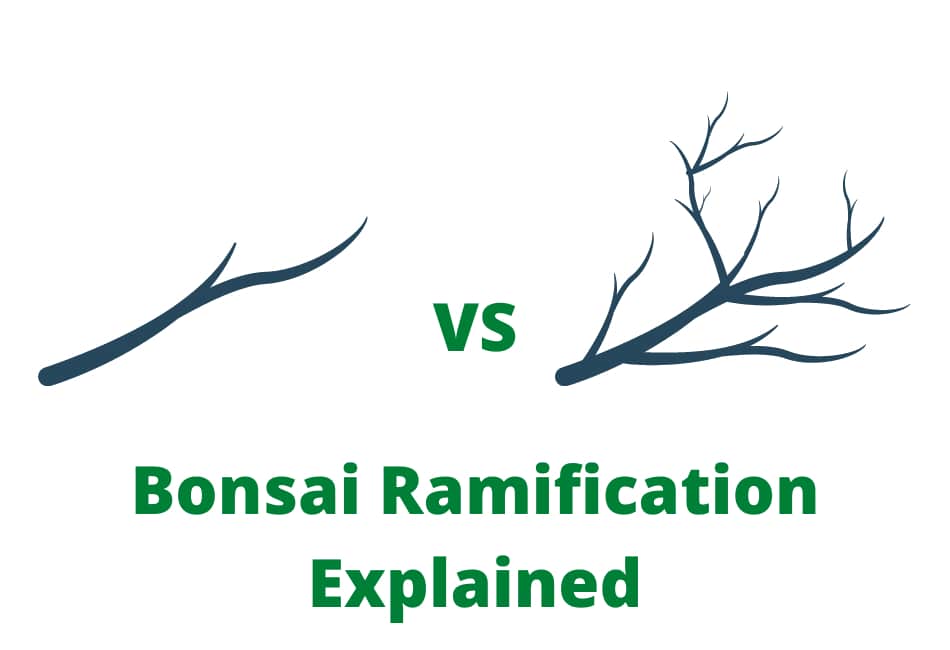
One of the things that I really struggled with when I first started my journey in bonsai was all the terms associated with the hobby. Defoliation, ramification heck even moisture trays. What exactly are these? and how can they help us, everyday hobbyists, with our bonsai trees?
Bonsai ramification is the process of growing, pruning, cutting, and finely dividing the small twigs and branches on bonsai, to give the appearance of larger trees. This is usually done by tapering your branches thinner the wider your plant gets.
So what are some examples of good and bad bonsai ramification, and what are some steps you can follow to ensure you have good bonsai ramification on your tree? Keep reading to find out more.
Just a quick heads up, over the past three years of running Plantpaladin, hundreds of people have asked for product recommendations. As such, You can find my favorite indoor bonsai tree here (link takes you to Bonsaiboy), my favorite outdoor bonsai tree (link takes you to Bonsaiboy), or have a look at all the products I recommend here.
What is bonsai ramification?
Picture a bonsai tree in your mind and one of the first things that will come to your head is a beautiful multi-branched tree, finally pruned and groomed to be the centerpiece of the garden.
One of the things then that I didn’t realize before I started my journey in Bonsai was just how complex the process was to get a plant species into a successful bonsai.
One of the best ways in which this is done is through the process of bonsai ramification.
Now bonsai ramification can be quite a difficult process to understand when you first get started so to summarize:
- Traditional ramification on normal trees is the divergence of branches and stems into smaller ones – think of this as how the trunk of a tree, branches of into larger branches, followed by smaller branches and then smaller twigs and then leaves
- This gives the appearance of a full tree that is visually appealing.
- Bonsai ramification then is the process of simulating this naturally occurring design in the art of bonsai, creating multiple branches and twigs, to give the appearance of a true miniature tree.
- As bonsai species are a lot smaller than normal trees, bonsai ramification is usually accomplished through the process of pruning, wiring, and generally looking after your bonsai.
- By using ramification successfully in a bonsai it can be used to create the appearance of a stronger, fuller denser tree.
Now I appreciate that this can be a tricky concept to understand without any images so hopefully, the examples below should give you an idea of what a bonsai with good ramification looks like vs a bonsai tree with bad ramification:
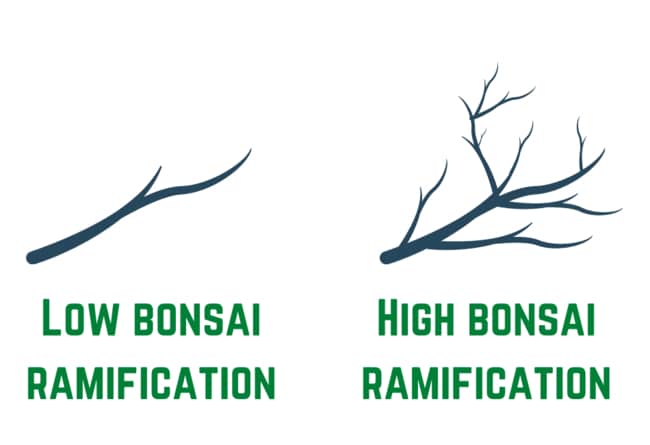
Bonsais then with lower ramification, will have fewer branches than seed out into thinner branches and twigs. This will make the process of having a dense tree as possible more difficult.
Having a plant with a lot of ramification then will make it a lot easier to prune and trim. The natural taper will give the illusion that your bonsai is a much more natural look making it easier to style your bonsai.
The increased branches will also sprout new leaves further adding density to your tree.
What does good bonsai ramification look like
Good bonsai ramification is a bonsai that has multiple branches sprawling off the main trunk of a bonsai giving the illusion of a full tree. Good bonsai ramification makes use of trimming your bonsai at nodes to generate multiple branches and stems.
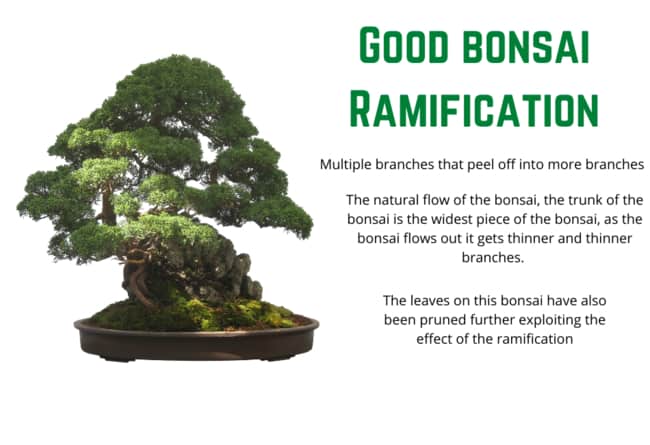
The bonsai in the image above has good ramification as it has multiple branches that branch off the main trunk of the tree.
These branches then further branch out into smaller stems that have been pruned and wired into place giving the appearance of a tree.
The ramification has allowed for a dense bed of leaves that have been trimmed and pruned into position.
What does bad bonsai ramification look like
Bad bonsai ramification will look like a bonsai tree that does not have a lot of branches and stems pooling out from the main trunk. On these occasions, bonsai trees will not look like miniature trees and instead look like short stumps needing time to develop.
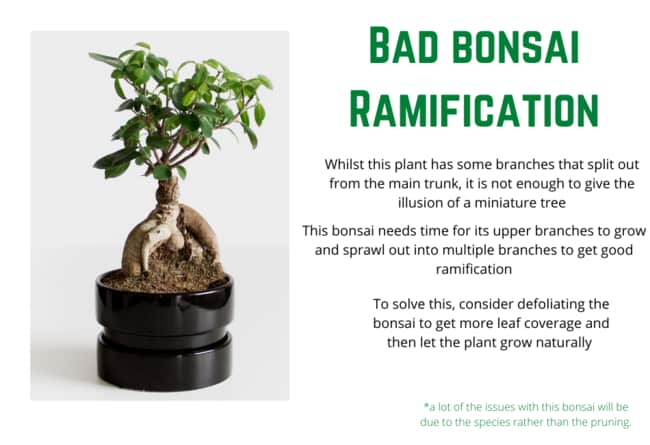
Now while the bonsai in the branch above has some ramification going on, it does not have enough to give the look of a true minute tree.
The ramification on this plant seems to only appear at the top of the bonsai and as a result, the leaf canopy comes across as looking thin.
To improve the ramification on this bonsai I would trim some of the longer branches back near the nodes in the summer in order to develop more branches and growth for this plant which should help with any density issues.
What does bonsai ramification do?
Bonsai ramifications help improve the amount of density and depth a bonsai tree has, giving the appearance of a miniature tree. This happens by trimming bonsai branches near nodes to help grow out more branches, giving a tapered look from trunk to branch to the twigs and tops of your bonsai.
The more ramification your bonsai tree has ( i.e the more branches, twigs, and nodes) your bonsai has, the more likely it is that it will give the appearance of a minute tree, making designing and pruning your bonsai a lot easier.
To help explain further, I’ve linked to some images below to see how bonsai ramification looks like underneath all the leaves.
The top image below is an example of a bonsai that in the summertime will be a lot easier to style due to tho the ramification vs the one below it which does not have as much ramification.
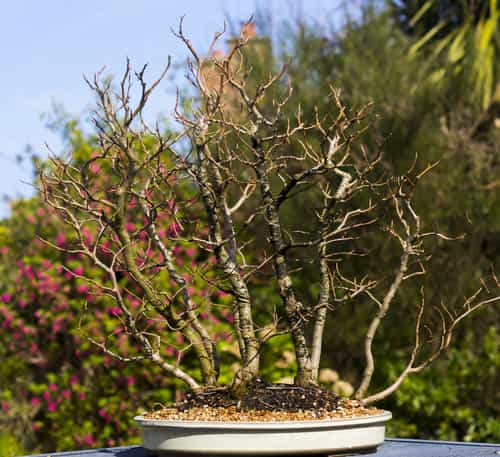
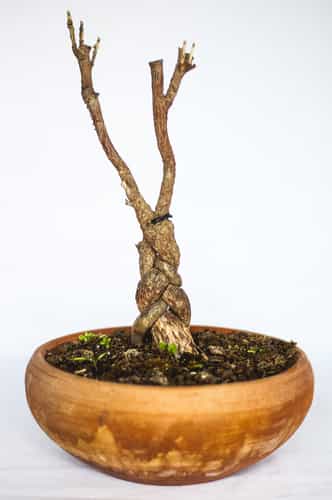
How to get more ramification on your bonsai
To increase the amount of ramification on your bonsai, trim the branches of your bonsai with a sharp pair of gardening scissors just after the nodes on a branch. When your bonsai starts to grow, new branches will form from these nodes giving your bonsai more branches and ramification.
A few other top tips to follow if you want to increase your bonsai ramification are to:
- Ensure you only trim branches that have been aged and matured. This is because nodes on younger branches may not sprout new growth until mature
- Consider using defoliation in accordance with ramifications as a way to massively increase the density of your tree.
- Trim and prune your bonsai regularly in order to stimulate growth.
What species can you get the best ramification from?
Chinese elms and any pine species are both fantastic options to use for bonsai ramification. This is because these species both naturally tend to generate a lot of branches and stems naturally and already look like minute trees. Creating ramification may prove more difficult with jade species.
How can you use nodes in bonsai ramification?
Nodes are incredibly important in the process of bonsai ramification.
You see, bonsai ramification is basically the art of making our bonsai imitate a normal tree.
This would typically look like having a thick trunk with multiple branches that eventually thin out into smaller branches and twigs giving a natural look.
The only way then, to mimic this in bonsai is by trimming your bonsai branches just after many nodes you have.
This will stimulate the growth of new branches and leaves from these nodes giving you more control of your ramification.
Is ramification the same as defoliation
Bonsai ramification and bonsai defoliation are not the same things. Whilst both are designed to increase the density of your bonsai, ramification is the process of trimming and growing out multiple branches and twigs of your bonsai. Defoliation is the process of trimming and removing all leaves from your bonsai.
To read up more on defoliation, check out my blog post talking all about it here.
When should ramification be used?
Bonsai ramification is a natural part of keeping bonsai and so you should attempt to increase the amount of ramification on your bonsai every year.
This could be as simple as trimming your branches at the nodes once in spring and once in the autumn to boost growth.
I would recommend however that if your plant is new then I’d potentially avoid using ramification on your bonsai as your plant needs to grow naturally before you start pruning it.
Is bonsai ramification the same as normal ramification?
Ramification takes place in trees naturally. The thick trunks of trees branch out into large branches, which then branch out into smaller branches and then twigs.
Ramification on bonsai is also naturally occurring, however as it takes a lot more time, often we have to speed the process up through pruning, trimming, and cutting branches to help growth.
Now a lot of you are in the process of starting your bonsai journey like I was not too long ago. if this is the case with you. i;d recommend reading the following posts:
My top picks for the gear you will need!
So like I mentioned earlier, over the past three years of running PlantPaladin, hundreds of people have asked me for my recommendations on the best bonsai gear on the market.
Having spent thousands of dollars on bonsai items these past few years and tested at least 100 bonsai-specific products, I’ve listed my favorite products below – All of which I highly recommend and think you can get great value.
They can purchase directly by clicking the link to take them to Amazon.
Bonsai Tool Set: One of the significant challenges I’ve had is finding a toolset that was not only durable but didn’t break the bank. SOLIGT has recently developed a fantastic bonsai tool set that covers all the tools you need to trim, prune, and repot your trees. – You can grab it here.
Complete Bonsai Set: Many of you will want to grow your bonsai trees entirely from scratch, but finding the varicose seeds, pots, and other items in one place can be challenging. Leaves and Sole then have created a complete bonsai set that I’ve personally used that ticks all the boxes. You can grab it here.
Bonsai wire: The number of times I’ve run out of wire for my bonsai or purchased cheap bonsai wire that doesn’t do the job is embarrassing for me to admit. After a lot of trial and error, I found that using Hotop’s aluminum bonsai wire is one of the best options on the market. This can easily be used for both indoor and outdoor bonsai. You can grab it here.
This post was written by Fehed Nicass who has been passionate about bonsai for over 2 years. He currently resides in the Uk and works in sales.
